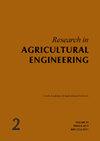Viability of some African agricultural by-products as a feedstock for solid biofuel production
Q3 Agricultural and Biological Sciences
引用次数: 1
Abstract
As a source of renewable energy, agricultural by-products after pre-processing and cleaning in post-harvest lines can be used as a feedstock for the production of pellets or briquettes. This can be achieved by determining the physicochemical properties of the by-products. Groundnut pods, maize cobs and the husks of rice, millet and sorghum were considered, and their properties were determined, which were then compared with the standard properties of pellets and briquettes to ascertain their viability as a feedstock for the pellet or briquette production. The by-products were transported from Nigeria to the Czech Republic and the research was carried out at the Department of Technological Equipment of Buildings, the Faculty of Engineering, Czech University of Life Sciences Prague. The moisture content, ash content, calorific value, nitrogen content and sulfur content were the properties considered of the by-products. Groundnut pods and maize cobs with a calorific value of 17.48 MJ·kg–1 and 16.25 MJ·kg–1, an ash content of 3.46% weight and 1.79% weight, a nitrogen content of 1.24% weight and 0.44% weight and a moisture content of 7.92 weight and 7.56% weight, respectively, were discovered to fulfill all the requirements for graded non-woody pellets A. With the exception of rice husks and millet husks, which were discovered to have high ash contents and low calorific values, all the by-products fulfilled the standard requirements for one or more grade of pellet/briquette. They can, therefore, be used as a good feedstock for pellet or briquette production.一些非洲农业副产品作为固体生物燃料生产原料的可行性
作为一种可再生能源,在收获后生产线中经过预处理和清洁的农业副产品可以用作生产球团或压块的原料。这可以通过测定副产物的物理化学性质来实现。考虑了花生荚、玉米棒以及大米、小米和高粱的外壳,并确定了它们的特性,然后将其与球团和型煤的标准特性进行比较,以确定它们作为球团或型煤生产原料的可行性。副产品从尼日利亚运往捷克共和国,研究在布拉格捷克生命科学大学工程学院建筑技术设备系进行。副产品的水分、灰分、热值、氮含量和硫含量是考虑的特性。花生荚和玉米芯的热值分别为17.48 MJ·kg–1和16.25 MJ·kg-1,灰分含量分别为3.46%和1.79%,氮含量分别为1.24%和0.44%,水分含量分别为7.92和7.56%,可满足分级非木质颗粒a的所有要求。除了稻壳和小米壳被发现具有高灰分和低热值外,所有副产品都符合一个或多个级别的球团/型煤的标准要求。因此,它们可以用作球团或型煤生产的良好原料。
本文章由计算机程序翻译,如有差异,请以英文原文为准。
求助全文
约1分钟内获得全文
求助全文
来源期刊

Research in Agricultural Engineering
Engineering, agriculture-
CiteScore
1.40
自引率
0.00%
发文量
21
审稿时长
24 weeks
期刊介绍:
Original scientific papers, short communications, information, and studies covering all areas of agricultural engineering, agricultural technology, processing of agricultural products, countryside buildings and related problems from ecology, energetics, economy, ergonomy and applied physics and chemistry. Papers are published in English.
 求助内容:
求助内容: 应助结果提醒方式:
应助结果提醒方式:


